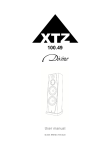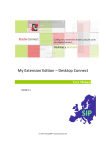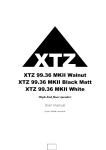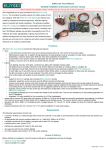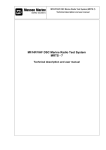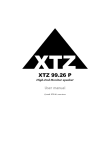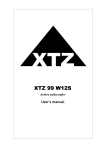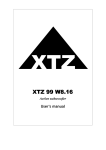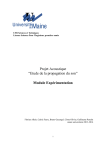Download Divine 100.49
Transcript
Divine 100.49 User manual © 2010 XTZ AB , www.xtz.se Table of contents – XTZ Divine Page: Contents About XTZ Technical presentation Preparations Practice of sound / Installation and placement tips Mounting /Area of usage Sound adjustment Technical specifications Service & Support 3 3 4 6 7 9 13 15 16 Contents Contents Congratulations to your purchase of the XTZ Divine 100.49 When combined with hifi and audio equipments; you will experience motion pictures or music records reproduced very deeply and naturally. Now when you watch your favourite movies or listen to your reference music CDs, you will hear and feel the sound surrounding you in the same way as originally intended by mastering engineers. Read the manual before using the product and use all possibilities carefully. About XTZ Philosophy Our reference and starting point is to recreate a natural sound, taking into account that acoustics always is a matter of taste. XTZ Goal Our main goal is to provide the best value for money. Our concept: - Cut down the numbers of middlemen - Put more money on product quality and less on advertising. - Manufacture cost-effective in large volume - Provide perfect technical solutions Contact Website: www.xtz.se E-mail: [email protected] 3 (16) Technical presentation Cabinet design The box design is designed in a special way. Everything is optimized for it’s reason and only the best solutions were chosen to obtain the best possible construction for sound reproduction. The cabinet wall is built with dual layers of MDF, using sound repressive glue between the layers. A convex wall construction is much stronger than a normal flat one, and this means that the convex walls can be thinner without loosing strength. Still, the walls are 28 mm thick. The internal modes are reduced a great deal if the walls are not flat and parallel. The result is an extremely silent construction with no inner resonances. The front baffle is 38 mm, made using a dual layer technique. The top of the speaker is made from 30 mm massive MDF plus internal bars. The cabinet has a total of 7 internal bars. The integrated foundation/feet construction is glued in a dual layer design and is 75 mm thick. The back of the speaker is a full 90 mm thick and glued together of two pieces of MDF. The Midrange has its own separate enclosure. The internal box of the midrange has a “v” shaped design to avoid parallel walls and to suppress the internal resonances to an absolute minimum. The damping material in the midrange box is a combination of mineral wool and synthetic absorbing material. The combination is an optimal blend of these materials. Both woofers are placed in the same box, so they can be fully used in our Room Tuning concept. The volume and absorbing materials are completely optimized. We put a lot of effort into obtaining the best mix of natural and synthetic wool to optimize resonance reduction. Tweeter driver We have chosen an ultra fast ceramic tweeter, made for reproducing crystal clear sound, even at a high SPL levels without any distortion. The tweeter is produced by the German company Visaton, and is an absolute reference class unit. It is shielded, with an internally damped cavity and a ventilated voice coil. The tweeter offers an extremely flat frequency response and a low resonance frequency. 4 (16) Midrange driver Thiel & Partner, also called Accuton, is one of the most famous manufactures of loudspeaker drivers. XTZ Divine 100.49 uses T&P C173N-T6-90, one of the best (if not the best) midrange driver in the world and can only be found in extreme High End loudspeakers. T&P C173N-T6-90 is a ceramic driver with a light cone, equipped with a neodymium magnet. The driver is extremely stiff and at the same time light, which contributes to the high sensitivity. The two black dots are far from a design gimmick. Thiel & Partner has put them there for a reason. They suppress a resonance from the cone. The Accuton driver offers the highest quality and highest resolution; this is the reason that this driver is put in the best speakers in the world. Woofer driver As woofers we selected two aluminium 10” drivers from the Norwegian company SEAS; which has been producing drivers the last 60 years. It is with this knowledge that Seas has built this driver. The woofer has a cone, made out of pure aluminium. The moulded metal basket is a "high flow" type that is acoustically transparent and offers high precision as the basket is shaped exactly thanks to the moulding process. This makes sure that the basket is very stable and efficiently reduces resonances. The basket is absolutely none magnetically, which contributes to a higher efficiency of the driver. A strong magnet combined with the light cone yields a high efficiency and a good transient response. Gold plated terminal reduces contact resistance and serves as anti-corrosion. Large windows in the basket both above and below the spider reduces sound reflection, air flow noise and cavity resonances. 5 (16) Crossover/Terminal When XTZ produced the Divine 100.49 a great deal of effort was put into the crossover filter. All passive components are the highest quality to minimize the influence on the signal. The crossover is placed in a separate enclosure. We use an optimal selection of air wound coils (with low internal resistance) and coils with steel cores (these accept a high level of magnetic saturation), MKP capacitors and MOX resistors. The terminal is divided into two input areas. One for passive (normal) and one for active drive. All terminal screws and inputs are gold plated. The active inputs have direct connection with the drivers. The thought behind this is that the speaker can be used fully actively in the future to get the most out of the system. When using the bypass jumpers in the middle of the terminal, the speaker is in “passive mode” and connected to the passive cross over It is possible to drive the woofers actively and gain the possibility to use DSP based room correction. There are three links/jumpers that can be used to alter the character of the speaker. One link/jumper for the tweeter (0 or +3dB) One link/jumper for the midrange (0 or -2dB) One link/jumper for the woofers (0 or +3dB) Preparations Unpacking Carefully unpack the speaker, and pay attention so you don't break anything. If possible, save the carton box for future transportations. If there should be damage on the loudspeaker, please contact your retailer. Accessories Bass reflex plugs (4 pcs) User manual Links/Jumpers for level adjustment and active/passive connection (18 pcs) 6 (16) Practice of sound / Installation and placement tips This chapter contains general information about loudspeaker placement and installation. These are general rules, so there are exceptions in some cases. In which room do you achieve the best sound? No matter how good the equipment is, in the wrong listening environment it will inevitably sound bad. There are some basic rules concerning a proper loudspeaker installation: Reflections Carpets, curtains and soft furniture absorb mid range and high frequency sound, and this is preferable. Big empty area, on the contrary, reflects it and produces hard reflections that may lead to blurry dialogue. Apart from colouring the sound, also the perspective of the sound will deteriorate. Reflections in the room can roughly be compared to the reflections that yield ghost pictures on a TV screen. Amplification of bass A loudspeaker that is placed near a wall, ceiling or floor will amplify lower frequencies in a sometimes frequencies not desirable way (since it may lead to an indistinct sound recreation). This amplification becomes even more obvious if the loudspeaker is placed near a corner. Thus, for a sound as clear as possible, the loudspeaker should be placed at least 30 cm (about 12 inch) away from the wall Some constructions are made to be placed closed to a wall. Furniture Be aware that furniture may vibrate and thus create bad sound at loud bass. Room dimension Quadratic rooms or rooms where the length is exactly twice as long as the width should be avoided, since they may create unwanted resonance. Placement of the subwoofer The placement of the subwoofer in the room dramatically affects the overall frequency response and sound level of the system. At low frequencies the effect of the room is strong. Even a slight change in the subwoofer's location can make a significant difference in the frequency balance. Patience and methodical experimentation is needed to find an optimal placement. The placement affects the phase difference between the main loudspeakers and the subwoofer. One basic rule is to place the subwoofer together with or near the front system (especially important if the front loudspeaker also propagate bass frequencies) as this will minimize the risk of phase eliminations in the room. 7 (16) Cables Try to keep them as short as possible. By its electrical parameters, a long conductor will have a bigger influence on the sound than a short one. It may also work as an antenna and thus receive various signals that may become a constant noise in an active subwoofer. Make sure that all connections are clean and not oxidized. All connections should be mechanically stable, both power, signal and loudspeaker cables. Signal cables should be separated from other cables. Front speakers To get the best result the front speakers should be placed symmetrical in front of the listener. The distance between the front speakers should be around 80% of the distance to the listener. In other words, the recommended angle between the front speakers should be 45°. Why use 2 Subwoofer There are more then one benefits of having 2 subwoofers instead of one. The sound pressure level will be higher. Less dips and standing waves in the room and a better frequency response in the room (and on sweet spot) The need of power is less, to reach the same SPL as with one subwoofer Finally Please remember that good sound is a matter of taste, so you have to experiment to obtain your favourite one. We wish you best of luck! 8 (16) Mounting and connecting tips Mounting alternatives XTZ Divine 100.49 can be placed standing by a wall. The wall behind and beside the loudspeaker influences both the bass level and the bass characteristics, so please be patient and try different distances to the rear and side walls. To place the speaker with a distance to the wall is often best, to decrease influence of the wall (room) Connect using the correct phase Always connect using the correct phase, from the +-pole on the amplifier to the +-pole on the loudspeaker and corresponding for minus (-). If you by accident connect the other way, there is no risk of damage. However, the sound will not be correct, especially in the lower frequencies. Overload At high load during extensive time periods, there is always the risk of overloading the driver and amplifier. All loudspeakers have a limited handling capacity for high power, so be careful not to play extremely loud and not to increase treble or bass settings to much. By increasing the bass or treble from 0 to max you will increase the power by about 16 times. The initial playing time It takes about 50 to 100 hours of initial playing time, for the drivers to sound optimal. During this time, the speaker may be used normally. 9 (16) The terminal is divided in two parts, one for the passive Connecting Passive cross-over drive and one for the active drive. It is important that the connection is done in a correct way. An incorrect connection can destroy the drivers. Passive connection When using passive drive, the speaker cable should be connected to “+” and “-“ to the upper part of the terminal. When the metal plates are connected between the terminal screws, only one pair of speaker cable is needed. N.B!!! A broken speaker that is caused by a connected in an incorrect way is NOT covered by warranty. Be careful when connecting the speakers with the amplifier. Passive drive is connected to the upper part of the terminal. Bi-wire or Tri-wire When using bi-wiring, remove the metal plates between midrange and woofer terminal screws. Using Tri-wiring, also remove the metal plates between midrange and tweeter terminal screws. Below is a drawing of how to connect the speaker when using a single wire. BI-AMPING When bi-amping, the metal plates between the terminal screws MUST be removed. See drawing below Bi- and Tri-amping is a passive connection, but each range is powered by a separate amplifier. It is important that all amplifiers have the same output level; else there will be a non correct frequency response curve. Make sure that the metal plates are removed from the terminal screws when bi- or tri-amping. See the different between single, bi- and tri-amping. 10 (16) TRI-AMPING When tri-amping, all the metal plates between the terminal screws should be removed. See drawing below Links/Jumpers for To change between passive and active drive, just remove the links/jumpers. Active/Passive When the jumpers are removed the passive cross over is drive disconnected. Below are drawings that show what links/jumpers that control the connection to the drivers. From the left: Woofers. In the middle: Midrange To the right: Tweeter When the link/jumper is in place, the construction is a normal passive speaker. Disconnecting the jumpers will allow direct connection with the drivers. When disconnecting the link/jumpers, active filters is a must. Without this the tweeter will be destroyed. See next page! Picture below shows a setting for active drive. No links/jumpers are used. Picture below shows a setting for passive drive. Links/Jumper configuration: From the left: Woofers. In the middle: Midrange To the right: Tweeter 11 (16) NB! A broken speaker that is caused by a connected in an incorrect way is NOT covered by warranty. Connecting Active drive When using active drive, make sure that the active cross over has the correct settings before connecting to XTZ Divine 100.49 A broken driver due to incorrect connection is not covered by warranty! Be careful when connecting the speakers when using active drive. Make sure to read the manual of the active cross over before connecting. It is important that the connection is done in a correct way. An incorrect connection can destroy the drivers. Active connection is done on the lower part of the speaker terminal. See picture below. Using active drive: • Remove all links/jumpers plates above the terminal screws. • Connect each speaker cable to the terminal screws for each range. To the lower part of the terminal plate Make sure that the active filter has the correct configuration and check that all connections are done in a correct way. Semi Active Drive It is popular to run the woofers active. With the construction that XTZ divine 100.49 have, this is easy. This gives an opportunity to use an amplifier or separate sub amplifier with DSP/room compensation for the woofers. Make sure that jumpers have the correct configuration for a semi active drive. 12 (16) Picture below shows a setting for semiactive drive, where the woofers are driven active. Sound settings Room Tuning Mechanical adjustment of the boundary frequency By using the supplied bass plugs in the bass reflex gates, you can alter the lower boundary frequency of XTZ Divine 100.49 This setting also depends on the size and shape of the room, and also on your own taste, so please has patience when trying out your preferred setting. The bass level can be adjusted in 3 different settings in the bass range. The figure below illustrates three basic settings. Deep bass With one bass plugs in one of the two gates you have the deepest possible bass, which may be suitable for smaller rooms. "Quick" bass Without bass reflex plugs in the gates, you have a "quick" bass which is especially suitable for large rooms where the lower frequencies often are amplified by the room. Closed box With two plugs in two gates you have the most flat frequency response This schematic picture (which does not shown actual measured curves) elucidates the different sonic characteristics of the bass frequencies. 13 (16) Basic setting for neutral bass reproduction Since the acoustics is determined by a wide range of external factors there exists no single neutral setting that will work properly for all cases. External factors that have influence on the sound include the room, the placing, output levels etc. Level adjustment Bass level set at mode 2 (0dB) Midrange level set at mode 2 (0dB) Treble level set at mode 1 (0dB) 2 bass plugs in the bass ports Tweeter: Mode 1/ 0dB In this mode the sound is neutral with a flat frequency response. Mode 2/ +3dB In this mode the treble level is increase by 3dB. Midrange: Mode 1/ -2dB In this mode the midrange level is decreased by 2dB Mode 2/ 0dB In this mode the sound is neutral with a flat frequency response. Woofer: Mode 1/ 0dB In this mode the sound is neutral with a flat frequency response. Mode 2/ +3dB In this mode the bass level is increase by 3dB 14 (16) The levels can be adjusted with the jumpers. Technical specifications Construction type 3 -way High End speaker Bass reflex cabinet that may be set as a closed box, and a total of three individual bass modes (Room Tuning). Bass level, midrange level and tweeter level can be adjusted in 2 steps. With the clever speaker terminal, the speaker can easily be changed into active drive for some or all drivers. Dimensions 220 x 1070 x 400 mm (W x H x) Weight 69 kg /st Cross over frequency 180Hz/2500Hz Magnetically shielded No Nom. Impedance 4 ohm Binding post Gold plated tri-wiring / Banana plug / Pole screw Efficiency 89dB Power 900 W Short term IEC 268-5 450 W Long term IEC 268-5 Tweeter Visaton ceramic tweeter. Magnetically shielded. Weight 1kg Midrange Thiel & Partner C173N-T6-90, Neodymium magnet Weight 3kg Woofer 2pcs 10” SEAS Aluminium cone, aluminium frame, High flow basket, 3kg magnet. Weight 4kg. Connections and settings • Gold plated tri-wiring. Active/Passive drive • Bass reflex, can be set to closed box (Room Tuning) • The bass can be set to three distinct modes using the supplied bass plugs • The bass level is adjustable in 2 different modes • The midrange level is adjustable in 2 different modes. • The treble level is adjustable in 2 different modes. 15 (16) (with foot) Service & support Where to send the product for a warranty repair For service we refer to your retailer. ALWAYS pack the product / part very carefully. For questions regarding service, contact us by email Unfortunately damages during [email protected] Web page: www.xtz.se transportation are very common. If the package is weak, the transporting company does not compensate damages. Save the original carton for futute transport. Always enclose a copy of the receipt and a description of the defect. Support Please contact our free of charge support if you need installation advice, or if any problem occurs during the installation. Contact us by e-mail [email protected] and include your phone number if you wish verbal help, and we will call you back. 16 (16)
















